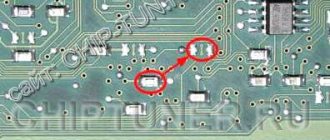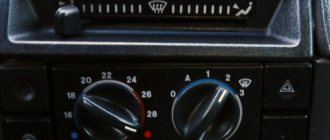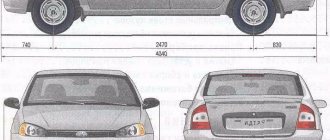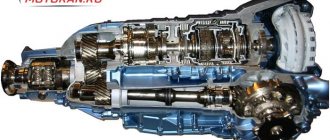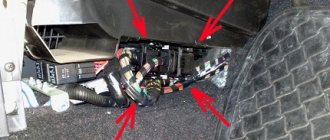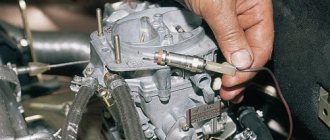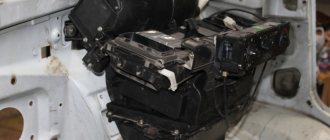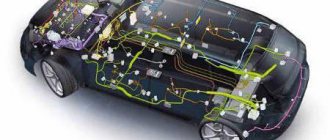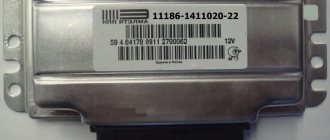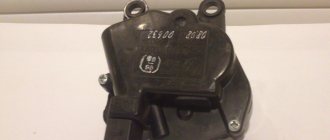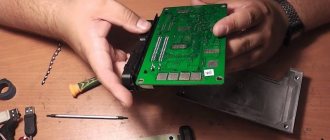ECU in a modern car
The first thing to start with is terms. The ECU is the “brains” of the car or the electronic control unit. Many people know it as a controller. It really is the brain of the machine. Without this block, all other elements and mechanisms simply turn into lifeless trash, a huge amount of plastic, wires and microprocessors.
The electronic unit receives data from sensors. The information is then processed using special algorithms. Next, it sends special commands to the actuators. There is an ECU even in models from AvtoVAZ. There are also sensors - for example, oxygen, coolant temperature, speed. What can we say about modern foreign cars?
This is the electronic control unit of the ECU. In simple words, this is a smart device that keeps under control all the processes that take place in cars every second. Up to a thousand different signals are processed per second.
What does the ECU consist of?
The ECU includes:
- ROM - read-only memory, also known as ROM - read-only memory, read-only memory. Firmware and calibration table data are stored here. The firmware is a control algorithm.
- 8-bit microprocessor RAM
- random access memory, also known as
RAM - random access memory. This is where data is stored that changes during operation. These can be intermediate results of calculations or values obtained from sensors. Unlike ROM, information in RAM is erased after turning off the controller's power. - Input signal conditioners. They coordinate the levels of input signals (amplification or attenuation). There are shapers of analog, discrete, and frequency signals.
- Output signal conditioners (drivers). They amplify the signal from the processor to control the actuators.
- converter (ADC). Converts analog signals to digital.
- CPU. Performs arithmetic and logical operations, controls signals to actuators and sensors.
- Power supply. Converts and stabilizes battery voltage to +5 volts. Some sensors are also powered from it.
- Input/output interface (input/output, I/O). Through I/O ports, input signals and information are read and output signals are sent.
What does the controller control?
We can list several main sensors from which information is collected. These are engine temperature, ambient temperature, lambda probe, fuel level and idle speed. Also, many cars have ABS sensors, brake pad wear and other sensors responsible for safety.
Individual elements control the speed of movement and the position of the electronic gas pedal. There is a crankshaft position sensor. The ECU also controls the operation of the cooling system and climate control. The unit monitors the correct operation of the brake system.
Naturally, this is not the entire list of sensors. This is a kind of standard set that is found on any more or less modern car. The VAZ-2170 ECU has approximately the same set of functions. We talked about sensors, but we also need to talk about actuators.
This is a throttle position regulator, an injector, an ignition system. The ECU also controls the distribution phases, the combustion temperature of the mixture and is able to maintain it. The unit analyzes the composition of exhaust gases. It regulates the lighting, controls the power windows, all heating, and the operation of robotic and automatic gearboxes.
This is just the minimum of what the average ECU can do. We already know what it is, so let’s move on - it will be interesting. On cars of a higher class there are many more sensors and devices.
In fact, the ECU is a small unit that keeps the operation of the entire car under constant control. Every system is controlled by this computer. People who are far from the automotive world and novice drivers think that the ECU looks like a laptop (after all, a computer?). But this is not true at all. The control unit is manufactured in a slightly different form factor.
Malfunctions of the electronic engine control unit and diagnostics
Although manufacturers make the ECU in the form of a protected box, placing the hardware inside a durable metal case, this device can also fail. Problems with the control unit may be accompanied by unstable operation of the internal combustion engine or the inability to start the engine, deviations in the mixture formation processes, disturbances in the operation of the transmission (usually automatic), etc.
To check the ECU, you should start with a visual inspection, which allows you to identify obvious defects (for example, cracks in the housing). However, if none are found, this still does not allow us to exclude possible damage to the microprocessor, since there are many reasons for the failure of this device.
Among the simplest, experts highlight:
- overheat;
- severe corrosion and moisture ingress;
- damage due to impact loads;
- short circuit;
Also, the culprit of the problems may not be the ECU itself, but poor contact with sensors, oxidation at the point where the wires are connected. Let us note that often problems with the control unit are caused by the banal irresponsibility of the car owner himself.
For example, when washing the engine under pressure, the block is not properly protected from moisture; the machine is operated in wet weather with elements removed (without fenders, hood). Owners often ignore the fact that the ECU is not securely mounted at the installation site or there are problems with the wiring, which can lead to a short circuit, etc.
The electronic unit can also be damaged by lighting it from another car with the engine running, unqualified installation of additional equipment in the car, or problems in the high-voltage part of the ignition system.
Let us add that there are also cases of complete failure of the ECU after attempts at unprofessional or independent repair of this type of device, as well as chip tuning. It is important to understand that on some models the block is irreparable, that is, a complete replacement of the block is expected.
In this case, after carrying out a superficial diagnosis, the owner removes the ECU and tries to disassemble/repair it. Then it often turns out that some sensor is still causing the problems, but after repair attempts the unit is no longer suitable for further use.
We also recommend reading the article about the disadvantages of chip tuning a car engine. From this article you will learn about the disadvantages of this solution, as well as what consequences for the engine may arise after flashing the ECU.
For this reason, it is important to understand that a comprehensive professional computer diagnostics must first be carried out. Only after this can you decide what to do, change or repair the engine control unit.
If we talk about an accessible check that a car enthusiast can perform on his own, this is a banal replacement of an existing unit with exactly the same one that is known to work. For example, you can borrow an ECU from the same car at a disassembly facility as collateral, install such a unit and check the operation of the internal combustion engine. If the machine works fine with the new unit, then the problem is obvious.
We also note that it is not always possible to eliminate a breakdown simply by replacing the controller. As mentioned above, often the root cause of ECU failure is not the unit itself. In simple words, if, for example, there is a short circuit in the wiring, the new control unit will quickly fail in the same way as the previous one.
What does the ECU look like and what does it represent?
The control unit is manufactured in a variety of housings. Often these are plastic or aluminum bases. For example, the VAZ-2172 ECU is made in a plastic case. Most foreign cars have a metal body. The material largely depends on the location of the block. So, if on models from AvtoVAZ the unit is installed in the passenger compartment, then it is made of plastic. If it were installed under the hood, it would be made of metal.
But the housing is not the entire ECU. Inside the case there is an electronic board. This is the ECU. We already know roughly what it is. Two connectors are brought out from the board - this is the so-called CAN bus. Wires from all sensors and actuators are connected to these connectors. It should be noted that some units are also equipped with a connector for updating firmware, as well as an OBD-II diagnostic output. Like any computer, this one also sometimes “glitches”. Failures also occur in sensors. Using the diagnostic connector, you can read the error codes of the VAZ ECU and then it will be easier to repair the car. You no longer need to search for breakdowns manually.
ECU chips are subject to quite strong heating. That's why their bodies have ribs. The latter perform the function of radiators, removing excess heat. If you take and look at the dismantled block, then in appearance the block is a small box measuring 15 by 10 cm, its thickness is no more than a centimeter.
ECU malfunctions
The most common cause of failure of the automatic transmission control module:
- a strong blow to the box (the computer board, processor or memory chip cracks);
- vibration effects;
- heat;
- voltage surges in the on-board network;
- corrosion due to moisture.
A malfunction of the transmission electronics leads to incorrect gear shifting or a situation where the automatic transmission goes into emergency mode, operating in only one gear (usually third). If there are any suspicions about the serviceability of the transmission ECU, you should contact a specialized service as soon as possible.
Important: driving with a faulty automatic transmission is strictly not recommended! This can lead to damage not only to the ECU, but also to the mechanical part of the box. The car should be transported to the service using a tow truck.
Diagnosis of a faulty transmission ECU is carried out using special equipment. Usually they try to simply replace a faulty ECU, since it is still relatively easy to resolder burnt capacitors, but replacing ECU chips is a labor-intensive operation, and a suitable chip still needs to be found. Therefore, often the best option is to replace the ECU; such a step will completely solve the problems with the box and return it to functionality.
Another important point is that only a knowledgeable specialist should repair the transmission ECU (or any other unit in principle). Automatic transmission repair services are offered by many “garage” services, but they are not able to guarantee the quality of the service, and after their intervention the transmission can “die” completely.
ECU from inside
If you open the block, you can see a fairly large board. Inexperienced car owners, and indeed inexperienced computer users in general, will confuse it with a computer motherboard. We will not understand its structure thoroughly, but will briefly talk about the main components.
Let's focus on ECU memory. What it is? There are several types of memory. PROM is a programmable constant where the developers have included the necessary algorithms for the operation of the engine and other systems. RAM is random access memory, which is necessary for working with intermediate information. It is processed in real time. EPROM is an electronic, reprogrammable memory. Used to store temporary data.
Software
Functional software is the most important. After all, it is through it that information from sensors is read and analyzed, and commands are also sent to actuators.
The modules monitor the received data for errors, if any can be detected. The software tries to correct errors if possible. If the error cannot be corrected, then Check Engine, etc. is displayed on the on-board computer display. There is no need to remember all the ECU errors. Their decoding is different for all types of cars. For example, on a Lada Priora, code P0353 indicates an open circuit in the ignition coil of the 3rd cylinder.
Types of ECU
Let's look at the types of electronic control units using the JEEP Grand Cherokee as an example.
Body Control Module (BCM)
On-board electronics control unit (door locks, power windows, interior lighting, etc.). The BCM is mounted to the driver's side fuse box below the dash.
Inside the BCM there is a chip that receives information from the sensors in the car through the Programmable Communication Interface (PCI).
PCI is designed to organize data exchange between the microprocessor and remote external devices.
bcm1-1
bcm3-3
bcm2-2
The BCM provides many electrical functions:
- interior lighting;
- external lighting;
- intermittent operation of windshield wipers;
- additional delay (this is a feature that allows you to use accessories, including the audio system, for up to 10 minutes after the engine is turned off);
- radio;
- heated seats.
Passenger Door Module (PDM)
Passenger door module. The PDM is located behind the right door trim. It is built into the door switch assembly.
pdm-1
pdm-2
pdm-3
Controls various electrical functions such as power door locks, power windows, power mirrors, lights, and rear door lock motor.
Airbag Control Module (ACM)
Airbag control unit. The ACM is located under the center console behind the gearshift mechanism.
acm-1-1
acm-1-31
acm-1-2
The microprocessor in the airbag controller contains the logic circuitry for the SRS (Supplemental Restraint System) system and controls all of its components.
Electronic Vehicle Information Center (EVIC)
Electronic vehicle information center.
The EVIC is located in the ceiling. Contains a compass, temperature, trip computer.
Controller Antilock Brakes (CAB)
Another name for BCM (Brake Control Module) is the brake system controller. Attached to the Hydraulic Control Unit (HCU) under the hood in front of the master cylinder.
CAB1
CAB2
CAB3
CAB4
CAB5
Controls the ABS anti-lock braking system. It also controls the brake force distribution system (EBD - Electronic brakeforce distribution).
Transmission Control Module (TCM)
Transmission control unit. It is located on the right (passenger) side of the engine compartment near the partition with the passenger compartment, attached to the inner fender.
Controls the gearbox, processing signals from speed and speed sensors in the automatic transmission, as well as temperature and pressure sensors. Stores adaptation information and OBD2 fault codes.
tcm
tcm2
tcm3
Sentry Key Immobilizer Module (SKIM)
Immobilizer module. Located on the underside of the steering column.
SKIM contains a radio frequency transceiver and a microprocessor. The immobilizer module transmits and receives signals from the chip in the ignition key.
When the ignition key is turned to the "On" position, SKIM transmits a signal to the transponder in the key. If the received response identifies the key as valid, SKIM sends a message to the engine control module (PCM) via the PCI data bus to enable starting.
If the received response identifies the key as invalid, or if no response is received from the key chip, SKIM sends an invalid key message to the PCM.
The engine control unit starts or blocks engine operation depending on the status of messages from SKIM.
Heated Seat Module (HSM)
Seat heating module. Located under the driver's seat. Performs the function of heated seats.
HSM
HSM2
hsm1
The heated seats are battery powered via a fuse. The HSM receives signals from the seat heating switches and turns on the heating elements. The low heating temperature setting is around 36°C and the high heating temperature setting is 42°C.
If the heated seat control module detects an open or short circuit in the heating element circuit, it will store the corresponding diagnostic trouble code.
Memory Seat Module (MSM)
Seat position control unit (memory module). Located under the driver's seat. Performs seat position memory functions.
MSM allows the driver to customize and personalize the shape and position of the seats. The seats are adjustable using small motors placed in different places to adjust different parts of the seat. The driver presses the position switch, which sends a signal to the control module to turn on the relay and start the motor.
Power seats allow the driver to change the position of the seat in different directions, such as forward, backward, up, down, recline forward, recline backward or change the position of the headrest to achieve an optimal driving position.
Driver Door Module (DDM)
Driver's door module. Located behind the left door trim, built into the door switch assembly.
Controls various electronic functions such as power door locks, power windows, power mirrors, auxiliary lights, and rear door lock motor.
Powertrain Control Module (PCM)
PCM - engine control unit. It is located under the hood in the right rear part of the engine compartment. It is a pre-programmed controller with three microprocessors.
It regulates ignition timing, air/fuel ratio, emissions, charging system, some transmission functions, speed control, air conditioning compressor clutch engagement and idle speed.
jebu3
jebu2
5
The PCM can adapt its settings depending on operating conditions.
Sunroof Module (SM)
SM - sunroof module.
SM1-1
SM1-2
SM1-3
Located in the ceiling, it is part of the hatch. Controls the opening, closing and ventilation of the hatch.
Rain Sense Module (RSM)
RSM - rain sensor module. Installed next to the rearview mirror so that it is in contact with the windshield.
The rain sensor operates on the principle of total internal reflection. This technique uses infrared radiation. Infrared light is emitted at a 45-degree angle onto a clear area of the windshield from a sensor inside the vehicle.
When it rains, wet glass causes the light to scatter and less light is reflected back to the sensor. When the amount of reflected light decreases to a level set by the software inside the sensor, it automatically turns on the windshield wipers.
The software also determines the speed of the wipers depending on the amount of moisture. This speed varies depending on the humidity detected by the sensor.
Adjustable Pedals Module (APM)
APM - pedal position control module. It is located under the panel, above the brake pedal. Controls the position of the pedals.
The adjustable pedal system is designed to move the brake and accelerator forward and backward. This improves ergonomics in relation to the steering wheel for tall and short drivers.
The adjustable pedals also allow the driver to adjust the steering wheel angle and seat position to the most comfortable position. The position of the brake and accelerator pedals is adjustable without compromising safety or comfort.
The APM control unit allows you to store one or two preferred pedal positions. The position can be saved and recalled using switches.
Previous post Combiloader 2.1.8 - program for flashing VAZ, GAZ, UAZ firmware
Next entry ECM Electronic engine control unit
Where is the ECU located?
In the cabin, the unit can be found under the panel. In models from AvtoVAZ it is located near the heater radiator. On business-level foreign cars, the ECU can be found under the rear seat. Some manufacturers try to install the controller in the trunk. Placing the ECU under the hood is not the best solution.
After all, the block is affected by rain, snow and other factors. Often in the engine compartment this device can be found near the battery or under the safety block. It’s not difficult to find – even an ordinary car owner without special skills can find it. You just need to disassemble the dashboard a little or find the unit under the hood. Externally, it is a box from which two wire harnesses extend. But you shouldn’t repair the ECU yourself without special knowledge. It is better to entrust this work to professionals.
Table of ECM masses in various vehicles
The mass in the ECM is usually the car body. If any of the contacts with ground loses reliability, the electrical circuit is disrupted, and the quality of system operation decreases. For example, the engine begins to randomly change its operating mode, gaining or decreasing speed without driver intervention. To cope with such a problem, you need to know the grounding locations of the ECM.
| Models | Grounding points |
| AvtoVAZ 2108-9 and 13-15 family 1. | The ECM weight is taken from the engine, from the bolts securing the plug on the right side of the cylinder head. In BOSCH 7.9.7 or January 7.2 controllers, the ground is taken from the pin that secures the dashboard center console frame to the floor tunnel (inside the center console, under the ashtray). |
| VAZ 2110-12 family, 1.5L. | From the bolts on the left side of the block head. |
| Family VAZ 2114, 21124 1.6L. | BOSCH controllers 7.9.7 or January 7.2. Weight for four ignition coils from the M6 bolt, weight to the ECM - from the stud on the ECU mounting bracket, on the left. On the stud - from the engine shield. Problems are possible here; you need to tighten the constantly loosening nut. |
| Niva with Bosch MP 7.0 controller. | From the bolts securing the plug in place of the ignition distributor - distributor. |
| Niva with Bosch M 7.9.7 controller. | The mass is taken from the body, from its mounting studs. A common problem is that the terminal is much thicker than necessary to press the castle washer evenly against the body. |
| Chevrolet Niva with Bosch MP 7.0 controller. | The ground is taken from the engine, from the M8 studs in its lower left part, under the ignition module. |
| Priora | C on the ECU mount (on the bracket). |
| Kalina | The ground contact is located on the right side of the engine, on the intake manifold mounting bracket. |
| Model range 2104-07. | Old controllers. The weight is taken from the bolt that attaches the ignition module mounting bracket to the engine. |
| Gazelle with engine 405, 406 | From a welded pin on the platform above the right side member, under the overhang of the engine shield. |
| UAZ Patriot with Mikas 11 E2 | Contact from the body through the welded pin at the bottom of the left mudguard. |
Dismantling
Removing the control unit is very simple. It is enough to unscrew the holding bolts and disconnect the cables. Naturally, before this work you should remove the negative terminal from the battery. On some car models, disassembly of the dashboard is required. Often the block is located on the side of the stove or under the glove compartment.
Finding out if the unit is working is very simple. In half the cases, the car simply will not start. It is also possible that all systems will be blocked, all locks will open, etc. In other cases, engine malfunctions may occur. So, on some cars the speed may fluctuate and failures may occur. The engine may not start at all. There are errors that cannot be removed using software. It should be noted that the ECU is a fairly reliable unit. Therefore, if you don’t specifically “heat” it, the unit will work for a long time and properly.
How do breakdowns happen if the unit is reliable? It's simple - all it takes is a short circuit or moisture getting on the board. Also, the ECU does not like physical influences and corrosion.
Problems and repairs
The engine ECU fails due to physical damage or incorrectly configured software. If the unit is acting up, the engine power will drop, the driver will feel “drawdowns”, high fuel consumption and other symptoms, and sometimes the engine refuses to start at all. The Check Engine indicator will light up on the panel, appearing even after the ECU errors have been reset.
ECU malfunctions occur for the following reasons:
- external influence on the ECU - moisture ingress and corrosion, strong shocks, constant significant vibration, overheating due to failure of the board cooling;
- electrical reasons - short circuit, overload in the vehicle's on-board network.
- An ECU is a complex and expensive device; replacing or repairing it is not cheap. To install a new module, it will have to be selected for a specific car so that the ECU fits all the parameters. And after selection and installation, the module will have to be configured correctly to ensure proper operation of all systems under its control.
Repair, replacement
It’s hard to say whether to repair the ECU or replace it. Sometimes the controller burns out completely, so much so that it can no longer be repaired. A new unit needs to be installed. And this is not so cheap - the average price is from 15 to 40 thousand rubles.
But if the error can be eliminated by replacing one or two microcircuits, then repair is advisable. If a track on the board has been eaten away by corrosion, this can also be restored.
ECU repair
As indicated above, it is impossible to accurately determine whether the unit is broken based on symptoms alone. Therefore, before repairs, it is necessary to diagnose the ECU, other units, systems and sensors, and check the wiring. When it is definitely established that the cause is in the ECU and it is not software in nature, repairs are made:
- Removing the block, checking the contacts.
- Opening and external inspection of the board to detect physical faults: breaks, damaged parts, etc.
- Replacement of damaged elements, restoration of soldering, tracks and other similar work.
- Voltage measurements, diagnostics.
- Assembly and sealing.
ECU repair by ADAKT representative.
If the problem is software related, disassembling the unit may not be necessary. In some cases, flashing the ECU or, conversely, reverting to factory settings helps. But in any case, the exact cause can be detected only after high-quality diagnostics and testing with an oscilloscope.
If you suspect that the ECU is malfunctioning, contact our partners for diagnostics. Specialists will determine the cause of the problems and, if necessary, repair the ECU (both software and hardware).
